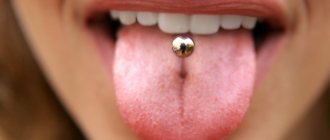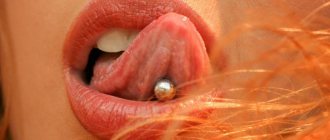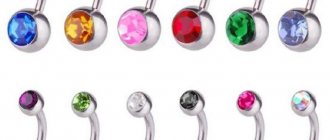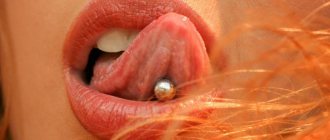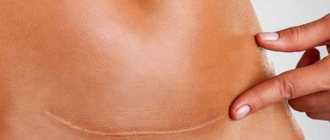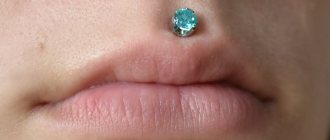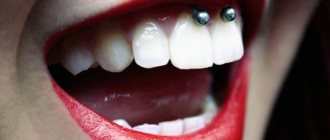Causes of infection after tongue piercing
From a medical point of view, piercing is a procedure associated with violating the integrity of the skin (invasive). And, like many other similar procedures, it can cause a variety of consequences. The following problems are typical for oral piercings:
- allergy to the material from which the jewelry is made, or to the drug that was used to treat the puncture site;
- formation of scars;
- chronic injury to teeth and mucous membranes;
- increased salivation (hypersalivation);
- development of infection and, as a consequence, inflammation [1].
Infection of a puncture site in the oral cavity occurs mainly for two reasons:
- After the procedure, the wound is not cared for or care is carried out incorrectly or irregularly.
- The biological balance in the oral cavity is disrupted due to the constant locally irritating effect of decoration.
In the oral cavity, a microbiome is formed and exists in a more or less constant quantitative and qualitative composition. This is a collection of microorganisms that normally (when there are no inflammations or other provoking factors) are in biological balance. This means that opportunistic microorganisms are not activated and do not lead to infection, because there are no prerequisites for this [2].
Only with the advent of molecular genetic research methods did the study of the biology of microorganisms (microbiome) truly begin as one of the leading triggers for the development and progression of inflammatory diseases of the dental system.
They inhabit the mucous membranes, the back of the tongue, the gingival sulcus, oral fluid and dental plaque, receiving the necessary proteins, carbohydrates, amino acids, inorganic and other substances from the oral fluid. Occupying only 0.03–0.05 m² of oral cavity area, the microbiome of this ecological niche includes representatives from 530 to 700 stable species. Katola V.M., Ph.D., leading researcher at the Institute of Geology and Environmental Management, Far Eastern Branch of the Russian Academy of Sciences [2]
Some microorganisms play a positive role in the health of the oral cavity, mucous membranes, and teeth. Thus, bifidobacteria, in the course of their life activity, help to increase local immunity in the mouth, suppress the development of pathogenic flora, and reduce the likelihood of developing caries. At the same time, streptococci, actinomycetes and other microorganisms increase the level of acids, which over time dissolve tooth enamel, which increases the sensitivity of teeth, decreases their mineral density (primarily due to the destruction of calcium and fluoride), and inflammation of periodontal tissues develops. which hold the tooth in the socket [2].
Tongue piercing as an injury and jewelry that is inserted into the hole changes the biochemical balance of the environment inside the oral cavity. The protective properties of saliva, the rate of its secretion and the activity of enzymes change, the hygienic condition of the oral cavity and teeth deteriorates, the mechanism of chewing and articulation changes. All this, in combination with other factors, leads to the creation of conditions under which “bad” bacteria, that is, opportunistic bacteria, multiply more actively. Microbes easily settle on the inflamed tissue at the puncture site, multiply and cause an infectious process. Most often, after tongue piercing, infection is associated with various pathogens: Actinomyces, Campylobacter, Neisseria, Streptococcus, Candida fungi and others [3, 4]
Rules for handling a pierced tongue
The long dumbbell can be replaced with a shorter dumbbell after at least ten days to avoid recurrence of tongue swelling. It is imperative to remove the formed plaque from the tongue and jewelry every day. A soft toothbrush is great for this. Cooled water, which it is advisable to drink every morning, will help reduce swelling on the tongue. In the first days after tongue piercing, you need to speak as little as possible, since unnecessary movements of the injured tongue and dumbbells can disturb the wound and cause bleeding from it.
To prevent swelling from increasing, during the healing period it is necessary to avoid spicy foods and hot liquid foods - soup, tea, coffee. Alcohol is also temporarily contraindicated.
It is also not recommended at the initial stages of healing to feel the dumbbell with the tip of your tongue and try to “play” with it - this will slow down the process of tissue regeneration and can provoke the formation of scars. It is also not recommended to remove the dumbbell, since the puncture of the tongue will heal very quickly and everything will have to be done anew. You should abstain from oral sex for at least fifteen days - kissing should also be postponed until the puncture is completely tightened.
Typical symptoms after piercing
Of course, not every piercing leads to infection, but some vigilance is needed. A tongue piercing is an injury, and it heals in the same stages as other injuries. This stage lasts, according to various sources, up to 10–14 days. Typical complaints and symptoms after piercing are:
- swelling;
- pain or discomfort in the puncture area;
- feeling of tightness, numbness of the tongue;
- tingling, burning, especially when food, drinks, or medications come into contact with the wound;
- discharge of a small amount of blood or yellowish serous fluid [1, 4].
Installed jewelry can be a factor of permanent trauma, and this leads to chronic low-grade inflammation, in which there is minor local swelling and slight redness due to disruption of the integrity of the epithelium.
Preparation for the procedure
To avoid the development of complications, it is important to know several points before starting the procedure:
- Select the first earring wisely: the alloy of the product should not oxidize. The first bar should be larger in size than the permanent one - this is due to the fact that after the puncture the tongue swells. When the canal heals and the swelling subsides, the temporary product is replaced with a smaller piece of jewelry. There should be no samples, engravings, or various patterns on the surface. If the bar is not smooth, the puncture channel takes longer to heal, as it is injured by the patterns. In this case, the healing period can be several months.
- Tongue treatment: during the operation, the specialist himself disinfects the puncture site. After the procedure, you will need a care product and rinse to rinse your mouth, which will be recommended by a specialist.
- Selecting a clinic and specialist: the main thing is health and safety, so it’s worth finding an experienced and trusted piercer. The place where the procedure is performed must be clean. A prerequisite for the operation of such establishments is the presence of a sterilization zone where disinfection equipment is located (trays, boxes, dry-heat ovens).
Possible signs of infection
If an infection is added to post-traumatic inflammation, local and general symptoms of infection occur. Their appearance is associated with a protective reaction at the local and general level of the body in response to chronic inflammation and changes in the microbial composition in the oral cavity. Accordingly, there are differences between local (in the oral cavity and on nearby tissues) and general manifestations of the infectious-inflammatory process associated with a cascade of reactions to the pathological process. These symptoms can appear at any time.
Local symptoms include:
- increased pain;
- the appearance of a twitching pain that can spread (give) to the ear, nose, submandibular area, and head;
- the tongue “tastes” hot, a change in its relief occurs;
- increased swelling;
- in the mirror you can see redness, sometimes whitish films, veins of blood vessels;
- the appearance of cloudy discharge, possibly with an unpleasant taste and odor [4].
General symptoms:
- increased body temperature;
- chills;
- body aches;
- decreased appetite;
- increased fatigue;
- enlargement of local lymph nodes (on the neck, on the back of the head, behind the ears) [4].
What to Avoid While Your Tongue Heals
What to avoid:
- Hard, sour, sticky, spicy foods.
- Talk too much.
- Kissing and any other use of the mouth with girlfriends/friends
- Putting foreign objects in your mouth.
- Smoking (it’s better to abstain at first, and once the piercing heals, then quit smoking altogether)
- Experiment with tongue decoration (you will have plenty of time for this after healing)
The swelling should go down in a couple of weeks, but the healing period may take longer.
Once pierced, the tongue usually takes three to four weeks to completely heal. This is one of the fastest-healing piercings as the enzymes in saliva help fight infection and kill bacteria.
This is interesting: Everything About Ear Piercing
You will need to use a good non-alcoholic mouthwash to help clean your mouth, but be careful not to over-clean, which can cause your tongue to turn green or brown. If this happens, simply reduce the amount of mouthwash you use and how often you use it.
- Days 1-5: After the first day, you will experience bloating. This will be worse during the first five days, when your speech will be impaired and you may have to change your diet to mashed potatoes, noodles, and other soft foods. Drinking cold drinks helps. For faster healing, you should avoid drinking alcohol or hot drinks, smoking, kissing, fiddling with or even touching a barbell, and ibuprofen and aspirin (which can increase swelling—use Tylenol instead).
- Days 5-7: The swelling will begin to decrease. Some people recover faster than others.
- Days 7-10: Swelling should go down now. When this happens, you need to have the bar replaced with a shorter one. The day you can replace the long barbell with a shorter one will depend on the amount of swelling you experience.
- Day 10-28: It may take 3 to 4 weeks to heal completely.
When can I remove the jewelry from my tongue and for how long?
The answer to this question varies from person to person. Tongues heal quickly, and even if the piercing is technically healed, it will also heal and close if you leave the jewelry out for an extended period. Some piercings can heal closed almost immediately in a day or two, while others with established piercings say they can go without jewelry for up to three weeks, don't worry.
This is interesting: Delicate Piercing: ideas for women and girls
How to prevent infection
There are many reasons for the development of infection after piercing, and they are not always associated with non-compliance with aseptic and antiseptic methods during puncture. But given the invasiveness of the procedure, you need to carefully choose a salon for piercing, focusing on the recommendations of Rospotrebnadzor. The main points of infection prevention are simple [5]:
- Do not carry out procedures during acute illness (colds, indigestion, herpes rashes, etc.) or during exacerbation of chronic diseases.
- Perform piercing only in a certified center, where the sterility of the instruments and the puncture process is maintained.
- Follow the recommendations for caring for the postoperative wound.
- Take regular and proper oral care [1, 4].
Lip piercing
Caring for a lip piercing has a lot in common with caring for a tongue piercing. It is also necessary to adhere to a diet, refrain from kissing and oral sex, and rinse the oral cavity with individually selected solutions of disinfectant liquids. The replacement of a long nail with a short one occurs in a similar way after the swelling subsides. But lip piercing requires additional attention: daily (preferably in the morning) the jewelry should be treated with saline solution, dissolving and removing the scab. After cleansing, the wound is lubricated with lavender oil, carefully turning the jewelry so that the oil gets inside. Healing usually takes about a month, sometimes complete healing can take up to eight weeks, which is absolutely normal. It is also normal for the jewelry to “nest”—move to the inside of the lip. Rings are more prone to this behavior than studs, as they are more mobile.
Non-dental infections after piercing
Like any injury, piercing reduces the body's defenses. At this time, dormant infections outside the oral cavity may become active and cause an acute process. If hygienic requirements, asepsis and antiseptics are not observed during piercing, there is a risk of contracting infections transmitted by “blood”, blood transfusion, when poorly treated instruments or hands, on which particles of infected blood of a sick visitor to the piercing salon remain, the infection enters the blood of a healthy one. This is how HIV, tetanus, and hepatitis are transmitted [1].
How to Identify and Treat a Tongue Piercing Infection
How infections develop
Infection occurs when bacteria gets inside the piercing. Tongue piercings—especially new ones—are more prone to infection than other piercings due to all the bacteria in the mouth. Most bacteria enter the body through food and drink. French kissing, oral sex, and other types of sexual activity can also carry bacteria.
Keep reading to learn how to identify an infection, relieve symptoms, and prevent further complications. Beauty salon enlarge individual parts of the tattoo.
How to identify an infection
If the piercing is new, irritation is normal.
During the first two weeks you may experience:
- Redness.
- Slight swelling.
- Light pulsation.
- Mild heat or warmth.
- Clear or white discharge.
Redness or swelling that extends beyond the piercing may be a sign of infection.
Other early signs of infection:
- Unpleasant swelling.
- Lasting warmth.
- Strong pain.
- Excessive bleeding.
- Pus or yellow discharge.
- A bump on the front or back of the piercing.
- Heat.
Mild infections can usually be treated at home. But if your symptoms are severe or if you are experiencing the infection for the first time. You should have your piercing examined immediately.
Non-infectious problems after piercing
Reactions to piercings are unpredictable and varied, but it is impossible to predict whether a particular patient will have them or not and what they will be. You should remember the risk of problems that are not related to the infectious-inflammatory process, but that affect the functioning of the dentofacial apparatus and the patient’s dental health. Piercing can provoke allergic reactions, periodontopathies, defects in hard dental tissues, tongue abscess, hypersalivation, impaired diction, galvanism, and scar formation [4].
How long does it take for a nose piercing to heal?
If proper care is followed, a nose piercing will take 4 to 10 weeks to heal. However, it is possible to remove the jewelry without harm or risk of infection only after six months.
Redness and ichor discharge persist for about two weeks. Regular treatment with Chlorhexedine, Miramistin and other means prescribed by the specialist will help speed up the process. To ensure that disinfectants get not only on the surface, but also inside the puncture, you need to slightly twist the earring.
Treatment of an infected tongue
If you experience complaints similar to an infection, you should consult a doctor to diagnose the causes and determine treatment tactics. It consists of removing decorative piercings (sometimes replacing them with silicone ones), antiseptic treatment, and prescribing local and systemic antibiotics. If necessary, the wound is drained, sometimes surgical excision is performed, followed by closure of the defect. It must be remembered that chronic trauma to the tongue due to piercing can lead to malignancy—cancerous degeneration [4].
How long does it take for an ear piercing to heal?
The punctured area is completely restored after 4-6 weeks. If more than a month and a half has passed and the healing of your ear piercing is still not complete, you should contact a specialist. But it’s worth considering that complete healing of a cartilage piercing takes much longer – about 5-8 months.
How long an ear piercing takes to heal depends on proper treatment of the skin with antiseptics. You need to rotate the earring every two days, otherwise it may grow on the young skin. It is recommended to use jewelry made of titanium, as it does not oxidize and does not cause allergic reactions.
How long does a nipple piercing take to heal?
In this area, the puncture heals on average after 6 months. Particularly careful care is needed in the first two weeks after the procedure. It is on these days that the channel is formed. The wound should be treated with antiseptics at least three times a day, as well as after taking water treatments. Disinfecting compresses help speed up and facilitate the healing of nipple piercings: applying a cotton pad soaked in an antiseptic and fixing it with a bandage. Such compresses should be applied three times a day and worn for about 15-20 minutes.
We have provided approximate recovery times.
It is quite difficult to say exactly how long a piercing will take to heal, since this is influenced by individual factors: immunity, lifestyle, bad habits, regularity of care, etc. Therefore, in real life, the period of tissue regeneration may differ. To minimize recovery and avoid complications, you must strictly follow your care provider's recommendations. Share link:
Types of maxillary sinusotomy
There are classical (radical) maxillary sinusotomy and endoscopic maxillary sinusotomy.
Radical maxillary sinusotomy
The maxillary sinus operation is used to open the maxillary sinus through the mouth.
Radical maxillary sinusotomy is carried out using local or general (as indicated) anesthesia and includes the creation of access, excision of soft tissue, opening of the maxillary cavity and removal of polyps or foreign objects, formation of an anastomosis connecting the maxillary sinus with the lower nasal passage. The operation takes about an hour.
1 Radical maxillary sinusotomy in MedicCity
2 Radical maxillary sinusotomy in MedicCity
3 Radical maxillary sinusotomy in MedicCity
The essence of the operation
With an intraoral gairotomy, the otolaryngologist makes a horizontal incision in the soft tissues of the upper gum and moves them upward. Then, using special instruments, part of the bone plate on the facial wall of the maxillary sinus is removed. Thanks to the hole made, the sinus cavity becomes accessible for manipulation, and the otolaryngologist removes the pathological contents using a sharp spoon.
After scraping the mucous membrane, an anastomosis is formed with the nasal cavity, smoothing out the bone defect. A flap is made from the remaining free mucosa and placed on the bottom of the maxillary sinus to restore epithelization of its walls.
At the end of the operation, a tampon is placed in the sinus, which is removed into the nasal passage, and the wound on the side of the mouth is sutured. Using a tampon, sterility of the sinus is achieved and the accumulation of blood and pus is prevented.
After 48 hours, after preliminary anesthesia, the tampon is removed, and the patient is prescribed vasoconstrictor drops and sinus lavage. After a week, the sutures in the mouth are removed.
Endoscopic maxillary sinusotomy
Endoscopic maxillary sinusotomy is very popular as a minimally invasive and more gentle technique. With endoscopic maxillary sinusotomy, the lip is not dissected; the operation is performed through the nose. The procedure is virtually painless, characterized by minor swelling after surgery and does not leave scars.
Endoscopic maxillary sinusotomy. Its advantage over conventional surgery:
- low morbidity;
- minimal blood loss;
- the ability to perform surgery on an outpatient basis;
- quick rehabilitation period for the patient;
- absence of cosmetic defect after surgery.
The essence of endoscopic maxillary sinusotomy
This type of operation is performed under local anesthesia using special endoscopic equipment through the nose.
The indication for endoscopic maxillary sinus, as well as for conventional surgery, is a severe purulent process in the maxillary sinus, for which conservative treatment has proven ineffective.
The duration of endoscopic maxillary sinusotomy is 20 minutes. The opening of the maxillary cavity occurs through the nose, and not an incision is made, but a minimal puncture with a diameter of about 5 mm. An endoscopic tube is inserted into this incision, and foreign objects and pathogenic material are removed using suction. All manipulations are performed under the control of an endoscope.
The following methods of endoscopic access to the maxillary cavity exist:
- through the middle nasal meatus;
- through the lower nasal passage;
- through the anterior stack of the sinus;
- through the alveolus of the tooth (if there is a fistula);
- through the tubercle of the maxilla.
1 Diagnosis of sore throat
2 Diagnosis of sore throat
3 Diagnosis of sore throat
The use of endoscopic maxillary sinusotomy helps reduce trauma to surrounding tissues and speed up rehabilitation after surgery.
With the help of endoscopic maxillary sinusotomy, it is possible to avoid the feeling of numbness in the teeth on the operated side, which the patient experiences during a conventional operation.
Highly qualified otolaryngologists of the Multidisciplinary Clinic "MedicCity" will help you in solving various ENT problems. We possess all modern methods of diagnosing and treating diseases of the ear, nose and throat.
